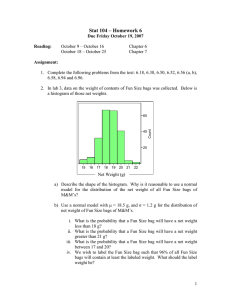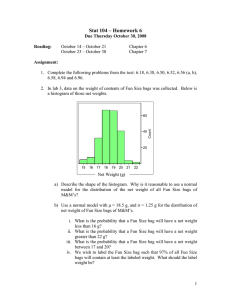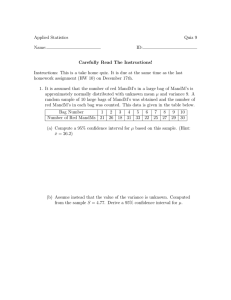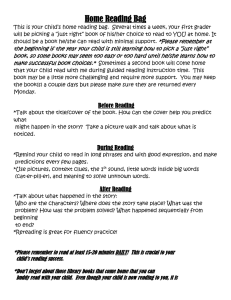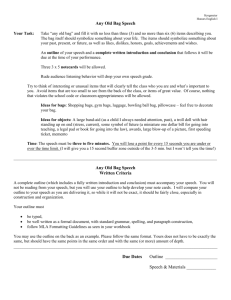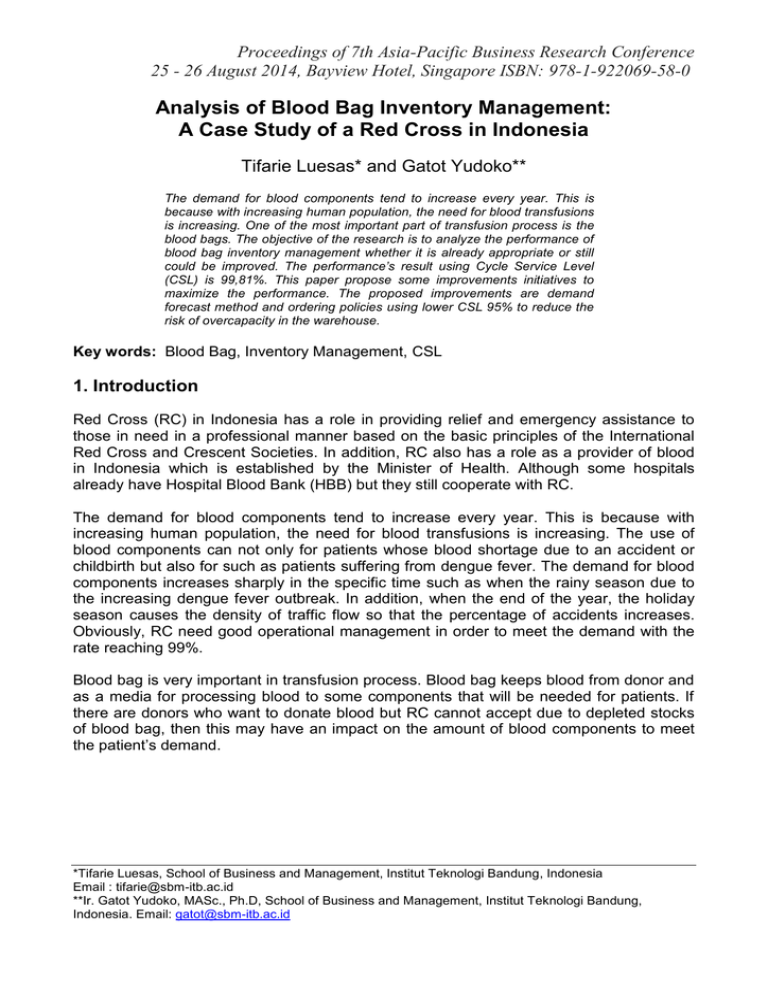
Proceedings of 7th Asia-Pacific Business Research Conference
25 - 26 August 2014, Bayview Hotel, Singapore ISBN: 978-1-922069-58-0
Analysis of Blood Bag Inventory Management:
A Case Study of a Red Cross in Indonesia
Tifarie Luesas* and Gatot Yudoko**
The demand for blood components tend to increase every year. This is
because with increasing human population, the need for blood transfusions
is increasing. One of the most important part of transfusion process is the
blood bags. The objective of the research is to analyze the performance of
blood bag inventory management whether it is already appropriate or still
could be improved. The performance’s result using Cycle Service Level
(CSL) is 99,81%. This paper propose some improvements initiatives to
maximize the performance. The proposed improvements are demand
forecast method and ordering policies using lower CSL 95% to reduce the
risk of overcapacity in the warehouse.
Key words: Blood Bag, Inventory Management, CSL
1. Introduction
Red Cross (RC) in Indonesia has a role in providing relief and emergency assistance to
those in need in a professional manner based on the basic principles of the International
Red Cross and Crescent Societies. In addition, RC also has a role as a provider of blood
in Indonesia which is established by the Minister of Health. Although some hospitals
already have Hospital Blood Bank (HBB) but they still cooperate with RC.
The demand for blood components tend to increase every year. This is because with
increasing human population, the need for blood transfusions is increasing. The use of
blood components can not only for patients whose blood shortage due to an accident or
childbirth but also for such as patients suffering from dengue fever. The demand for blood
components increases sharply in the specific time such as when the rainy season due to
the increasing dengue fever outbreak. In addition, when the end of the year, the holiday
season causes the density of traffic flow so that the percentage of accidents increases.
Obviously, RC need good operational management in order to meet the demand with the
rate reaching 99%.
Blood bag is very important in transfusion process. Blood bag keeps blood from donor and
as a media for processing blood to some components that will be needed for patients. If
there are donors who want to donate blood but RC cannot accept due to depleted stocks
of blood bag, then this may have an impact on the amount of blood components to meet
the patient’s demand.
*Tifarie Luesas, School of Business and Management, Institut Teknologi Bandung, Indonesia
Email : tifarie@sbm-itb.ac.id
**Ir. Gatot Yudoko, MASc., Ph.D, School of Business and Management, Institut Teknologi Bandung,
Indonesia. Email: gatot@sbm-itb.ac.id
Proceedings of 7th Asia-Pacific Business Research Conference
25 - 26 August 2014, Bayview Hotel, Singapore ISBN: 978-1-922069-58-0
2. Literature Review
2.1 Blood Bag
Blood bag is used for collection and separation of blood components. Available in single,
double, triple and quadruple with CPDA-1 anticoagulant solution or CPD/SAGM which
preserves red blood cells up to 35 days or 42 days.
Each type of bag have different function. For single bag, it will used for Whole Blood (WB);
double bag is used for processing blood into Packed Red Cells (PRC) and Fresh Frozen
Plasma (FFP); triple is used for PRC, Thrombocyte Concentrate (TC) and Liquid Plasma
(LP); and quadruple is used for PRC, TC FFP and Buffy Coat (BC).
2.2 Inventory management
Inventory is finished goods and goods in the production of goods funds available, owned in
the course of a vault or consignment to other parties at the end of the period (Koher,
2009:101).
The importance of inventory management is to the maximum performance of the company
or organization, especially in the operational activities. According to Heizer and Render
(2011:500), inventory has four basic functions, which are:
1. To “decouple” or separate various parts of the production process.
2. To decouple the firm from fluctuations in demand and provide stock of good that will
provide a selection for customers. There are many possibilities of fluctuations such as
increase demand of upward trend.
3. To take advantage of quantity discounts. Purchasing in larger quantities may reduce
the cost of good their delivery.
4. To hedge against inflation and upward price changes.
3. Methodology
The methodology of the research is the systematic step that will be started from initial
research, problem identification, theoretical foundation, research, data gathering, data
processing and analysis, solution, conclusion and recommendation.
Firstly, initial research is the step to find problems that can be used as the topic of the
research. This step identifies the problem in the Red Cross that will be discussed in this
research. In this step, the research will use theoretical foundation as the base to
understand the knowledge and information in doing the research. Secondly, based on
problem identification and theoretical foundation in initial research, author will collect data
that needed for the research. The author divides the data into two categories: primary data
and secondary data. Primary data is data obtained directly from the source. Primary data
came from observations or interviews with informants. In this research, the author uses
primary data from the Division of General Affairs & Logistics (DGAL). The primary data
gathered by interviewing DGAL. The data gathered are the information related to existing
inventory system, product information, ordering cost, holding cost, product cost and
process business information. Secondary data is data that has been arranged in the form
of written documents. Secondary data was obtained from the documents and management
reports of Red Cross, especially in DGAL and administration. The following data are
Proceedings of 7th Asia-Pacific Business Research Conference
25 - 26 August 2014, Bayview Hotel, Singapore ISBN: 978-1-922069-58-0
company profile, structure organization, ordering data for blood bag year 2012-2013 and
blood bag usage data year 2012-2013. Secondary data also using some literature that
supports such as books, newspapers, magazines, articles, journals and the results of
previous studies.
Thirdly, analysing data will be used by quantitative and qualitative. Qualitative analysis will
be used to identify process business and the existing inventory management system for
blood bags in Red Cross. For quantitative analysis will be used to analyse the inventory
managements of blood bags which are existing and based on theories. It will be analysed
using Microsoft Excel software. The existing inventory management will be analysed about
its performance using Cycle Service Level (CSL). Based on analysis, author will be
identified for the possibilities to be improved. The improvement will based on theoretical
foundation. Fourthly, after the data analysis step, the solution for the problem is generated.
The solution is based on theoretical foundation and the result of analysis. The solution is
made to improve the inventory management of blood bag in a Red Cross in Indonesia.
Finally, this stage concludes the findings in each stage of the research that will answer the
stated research questions. This stage also contain the recommendation that can be
implement by Red Cross in managing their blood bag inventory.
4.The findings
4.1 Analysis of Existing Inventory Management
Currently the Red Cross use blood bag with 4 types, single, double, triple and quadruple.
Blood bags will be processed by Blood Service Section, starts from screening test until
storage in form of various blood components.
Classification of blood bag in the Red Cross is based on the function of blood bag. Later,
the blood bag will be processed to get the blood components into Whole Blood, Packed
Red Cells, Thrombocyte Concentrate, Fresh Frozen Plasma, Liquid Plasma and Whole
Blood.
Blood Bag
Type
Single
Double
Triple
Quadruple
Whole
Blood
Table 4-1 Blood Bag Classification
Blood Components
Fresh
Packed Red Thrombocyte
Frozen
Cells
Concentrate
Plasma
Liquid
Plasma
Buffy
Coat
v
v
v
v
v
v
v
v
v
v
The Red Cross (RC) use blood bag that manufactured by JMS Singapore. Blood bag by
JMSS is better than by other manufacturers that RC already tested. The layer have right
thickness, not too thin nor too thick. The needle size is small and thin, so that doesn’t
make donors hurt. The price of blood bag depends to its type.
To analyse the performance of existing inventory management, it is need to evaluate the
cycle service level. By evaluating the service level, the risk of stock out can be identified.
Proceedings of 7th Asia-Pacific Business Research Conference
25 - 26 August 2014, Bayview Hotel, Singapore ISBN: 978-1-922069-58-0
Based on interview, the reorder decision is when the inventory of all blood bag type drops
to 1600 bags. The monthly demand from 2012-2013 is 9153 bags and the standard
deviation is 1327. The replenishment lead time is two days.
Table 4-2 Cycle Service Level
ROP
1600
D
9153
σD
1327
L in month
0.067
DL
610.2
σL
342.6299
CSL
99.81%
The Cycle Service Level of existing inventory management is 99.81%. It shows that based
on the performance The Red Cross has high service level and low probability of being
stock out. Although they have high service level, sometimes this can be a problem to the
Red Cross. The warehouse can’t accommodate overstock because they have capacity
limit.
4.2 Analysis for Proposed Improvement
Although the existing system has shown a high CSL, but there are a few possible
improvements that can be done in the future. These may include such as demand
forecasting method and ordering policies.
The process of inventory management of blood bag in the Red Cross is identified using
push processes. In push processes, it is very important to have appropriate demand
forecast because the processes operate in an uncertain environment because customer
demand is not yet known.
The other possible improvements is regarding order policies. Every organization or
company needs appropriate inventory management in order to reach the target with
effectiveness and effectiveness. Another reason are to minimize the error and fraud, get
quantity discounts, hedge against inflation and etc.
There are several weaknesses in existing inventory system. In demand forecasting, to
determine the amount of stock needed, they used assumption for the forecast. The
assumption is based on estimation of next month’s requirement. There is no appropriate
demand forecasting method of blood bag. They forecast demand for short period. For
example, the daily usage of blood bag is 300 bags per day. For the next month
requirement, there is an event with target around 1000 donors. The blood bag usage will
be around 10000 bags. The Red Cross will order 10000 bags for the next month.
Besides that, The Red Cross doesn’t specify the Q for each bag type. There are also no
specified reorder point and appropriate safety stock. By improving the order policies, The
Red Cross can handle better their inventory management of blood bag especially in a
urgent case such as high demand.
First, the improvement needed for The Red Cross is demand forecasting. Using past data,
author will identify the appropriate method for forecasting demand that specifies for each
bag type.
1. Single Blood Bag Demand Forecast
Proceedings of 7th Asia-Pacific Business Research Conference
25 - 26 August 2014, Bayview Hotel, Singapore ISBN: 978-1-922069-58-0
Figure 4-3 Single Blood
Bag Usage
Single Blood Bag
Month
2012
Jan
242
Feb
308
Mar
342
Apr
308
May
309
Jun
246
Jul
302
Aug
306
Sep
268
Oct
183
Nov
147
Dec
256
2013
254
238
237
258
248
168
153
235
203
155
158
168
For single blood bags, both years have similar pattern of blood bags usage. There is a
decrease around 23% of blood bag usage in 2013 than in 2012. From the graphic, it can
identified that there is declining trend of single blood bag usage. The health industry
nowadays decrease using whole blood that produced from single blood bag because it’s
more better using only the blood components needed rather than using whole blood. For
the future demand, IRC can use simple proportion to calculate their future demand. The
simple proportion can be used if historical data shows the trend.
For example, the author will forecast demand for 2014 using simple proportion. The data
use demand from 2012-2013.
Table 4-3 Single Blood Bag Usage
Proceedings of 7th Asia-Pacific Business Research Conference
25 - 26 August 2014, Bayview Hotel, Singapore ISBN: 978-1-922069-58-0
Total
σ per month
3217 2475
5692
59
From the past data, there is a decreased 23% of single blood bag usage from 2012-2013.
For example, author use 23% to decrease the next year annual demand. The annual
demand for 2014 is 1904.
The next step is to calculate seasonal factor. First, author finds the seasonal factor from
2012-2013. Then, the seasonal factor from 2012-2013 will be used to be seasonal factor
year 2014 after found the average of seasonal factor each month.
Table 4-4 2014 Seasonal Factor
Average for 2014
1.046
1.151
1.221
1.193
1.174
0.873
Proceedings of 7th Asia-Pacific Business Research Conference
25 - 26 August 2014, Bayview Hotel, Singapore ISBN: 978-1-922069-58-0
0.959
1.141
0.993
0.713
0.643
0.894
The seasonal factor for 2014 will be multiply with annual demand. By using simple
proportion, IRC can forecast their demand for short term period.
Table 4-5 2014 Demand Forecasting
Month
Jan
Feb
Mar
Apr
May
Jun
Jul
Aug
Sep
Oct
Nov
Dec
Demand Forecasting
166
183
194
189
186
138
152
181
158
113
102
142
2. Double Blood Bag Demand Forecast
Figure 4-4 Double Blood Bag Usage
Proceedings of 7th Asia-Pacific Business Research Conference
25 - 26 August 2014, Bayview Hotel, Singapore ISBN: 978-1-922069-58-0
Differ from single blood bag usage, there is no trend of double blood bag usage. Both of
years have the highest usage in September. There is an increasing use of bags around
4% in 2013. Because there is no trend, it is suggested to forecast demand using moving
average. In using moving average, IRC only able to forecast in short period.
IRC is suggested to use 12-month period moving average, because this method has the
smaller standard deviation than with other periods.
Table 4-6 Standard Deviation of Double Blood Bag
Months Period
σ
2
1516
3
1215
4
1231
6
989
9
603
12
579
For example, if IRC want to forecast January 2014 with a twelve-month moving average,
they can take the average from January to December. When January passes, the forecast
for February would be the average from February to January.
Table 4-7 Moving Average Method for Double Blood Bag
Month
1
2
3
4
5
6
7
8
9
10
11
12
13
Demand
Level
Forecast
Error
Absolute
Error
4685
7241
8190
7005
5899
5490
6019
3558
9208
6309
4827
6254
5206
6224
6267
6224
1018
1018
MSE
94165
MAD
93
%Error
MAPE
20
20
TS
11.00
Proceedings of 7th Asia-Pacific Business Research Conference
25 - 26 August 2014, Bayview Hotel, Singapore ISBN: 978-1-922069-58-0
14
15
16
17
18
19
20
21
22
23
24
5214
8150
6631
6410
6753
5310
5881
8322
6830
6723
6900
6098
6095
6064
6106
6212
6153
6346
6272
6316
6474
6528
6267
6098
6095
6064
6106
6212
6153
6346
6272
6316
6474
1053
-2052
-536
-346
-647
902
272
-1976
-558
-407
-426
1053
2052
536
346
647
902
272
1976
558
407
426
178748
488819
474431
450795
448757
470174
448148
630048
614100
592758
574076
173
317
333
334
353
385
379
463
468
465
463
20
25
8
5
10
17
5
24
8
6
6
20
22
18
16
15
15
14
15
14
13
13
12.00
0.06
-1.55
-2.59
-4.27
-1.58
-0.89
-4.99
-6.13
-7.05
-8.00
Using twelve month period moving average, the demand forecasting for January will be
6528 bags.
3. Triple Blood Bag Forecast
Figure 4-5 Triple Blood Bag Usage
For triple blood bag usage, there is fluctuation of blood bags usage in 2012. Blood bag
usage increases 16% in 2013 than in 2012.
Similar with double blood bags, the demand graphic of triple blood bags also shows no
trend. The author suggested to using moving average to forecast the future demand.
Proceedings of 7th Asia-Pacific Business Research Conference
25 - 26 August 2014, Bayview Hotel, Singapore ISBN: 978-1-922069-58-0
Table 4-8 Standard Deviation of Triple Blood Bag
Months Period
σ
2
308
3
298
4
289
6
559
9
287
12
296
For triple blood bag, the result of the smallest standard deviation is the opposite of double
blood bag. The result is the nine-month period. It is suggested for The Red Cross to use
moving average nine month period in forecasting demand for triple blood bag.
Proceedings of 7th Asia-Pacific Business Research Conference
25 - 26 August 2014, Bayview Hotel, Singapore ISBN: 978-1-922069-58-0
Table 4-9 Moving Average Method for Triple Blood Bag
Demand
2132
1946
2261
1858
2233
1965
2286
2196
1899
2198
2105
2451
2680
2183
2159
2797
2794
2636
2284
2339
2314
2756
2466
2238
Level
2086
2094
2111
2132
2224
2218
2240
2296
2363
2445
2454
2480
2465
2474
2505
2514
Forecast
Error
2086
2094
2111
2132
2224
2218
2240
2296
2363
2445
2454
2480
2465
2474
2505
-112
-11
-340
-548
41
59
-557
-498
-273
161
115
166
-291
8
267
Absolute
Error
112
11
340
548
41
59
557
498
273
161
115
166
291
8
267
MSE
12494
6313
42691
107003
85933
72193
106254
123918
118437
109178
100462
94396
93644
86959
85914
MAD
112
62
154
253
210
185
238
271
271
260
247
240
244
227
230
%Error
5
1
14
20
2
3
20
18
10
7
5
7
11
0
12
MAPE
5
3
6
10
8
7
9
10
10
10
10
9
9
9
9
TS
-1.00
-2.00
-3.00
-4.00
-4.61
-4.92
-6.16
-7.26
-8.26
-8.00
-7.95
-7.48
-8.56
-9.16
-7.89
Using moving average, The Red Cross can forecast demand for short term period. For
example, the forecast for January 2014 is 2514 bags. For the next month, IRC must added
the previous nine month actual demand divided by nine to get the forecasting.
4. Quadruple Blood Bag Forecast
Figure 4-6 Quadruple Blood Bag Usage
Proceedings of 7th Asia-Pacific Business Research Conference
25 - 26 August 2014, Bayview Hotel, Singapore ISBN: 978-1-922069-58-0
Quadruple Blood Bag Usage 2012-2013
400
300
200
100
0
Jan
Feb
Mar
Apr May
Jun
Series1
Jul
Aug
Sep
Oct
Nov
Dec
Series2
In 2013, there is similar pattern of blood bag usage as in 2012, but there is a decrease in
February and August. There is also has an increase of 49% from 2012. Like double and
triple blood bags type, the quadruple blood bags also shows no trend. It is suggested to
using moving average.
The quadruple blood bags results for 2 month period moving average. The standard
deviation of quadruple blood bags is the smaller compared to the other blood bags.
Table 4-10 Standard Deviation of Quadruple Blood Bag
Months Period
σ
2
38
3
40
4
40
6
44
9
56
12
72
Table 4-11 Moving Average Method for Quadruple Blood Bag
Month
Demand
Level
Forecast
Error
Absolute
Error
1
2
3
4
5
193
182
178
183
225
188
180
181
204
188
180
181
10
-3
-45
9.5
3
44.5
MSE
90
50
693
MAD
%Error MAPE
10
6
19
5
2
20
5
3
9
TS
1.00
1.04
-2.00
Proceedings of 7th Asia-Pacific Business Research Conference
25 - 26 August 2014, Bayview Hotel, Singapore ISBN: 978-1-922069-58-0
6
7
8
9
10
11
12
13
14
15
16
17
18
19
20
21
22
23
24
183
182
187
225
162
201
243
258
194
259
252
318
301
312
265
318
275
348
349
204
183
185
206
194
182
222
251
226
227
256
285
310
307
289
292
297
312
349
204
204
183
185
206
194
182
222
251
226
227
256
285
310
307
289
292
297
312
21
22
-5
-41
44
-8
-62
-36
57
-33
-26
-63
-16
-3
42
-30
17
-52
-38
21
22
4.5
40.5
44
7.5
61.5
36
56.5
33
25.5
62.5
16
2.5
41.5
29.5
16.5
51.5
37.5
630
601
504
666
825
740
1044
1067
1244
1232
1191
1372
1302
1226
1253
1233
1185
1255
1262
20
20
17
21
24
22
26
27
29
30
29
31
30
29
30
30
29
30
30
11
12
2
18
27
4
25
14
29
13
10
20
5
1
16
9
6
15
11
10
10
9
10
12
11
13
13
14
14
14
14
14
13
13
13
12
13
13
-0.87
0.25
0.03
-1.93
0.17
-0.16
-2.52
-3.78
-1.52
-2.63
-3.53
-5.27
-5.96
-6.38
-4.83
-5.83
-5.39
-6.91
-8.07
The demand forecasting for Jan 2014 will be 349 bags. The proposed improvement of
forecast will help IRC in managing blood bags. An appropriate forecasting is very needed
to anticipate the demand especially for push processes.
The second improvement is the order policies. Based on data, author identify the inventory
system of existing inventory management. Author identified that the existing inventory
management use Q system. It based on order quantity, decision to place order,
recordkeeping, size of inventory, time to maintain and type of items. It can be concluded
as Q system as follows the table:
Table 4-12 Replenishment policies
Criteria
When to place order
Existing System
When inventory drops to 1600 point
Analysis
Q system
Recordkeeping
Each time a withdrawal or addition is made
Q system
Size of inventory
Small
Q system
Time to maintain
everyday
Q system
Type of inventory
Critical items
Q system
Proceedings of 7th Asia-Pacific Business Research Conference
25 - 26 August 2014, Bayview Hotel, Singapore ISBN: 978-1-922069-58-0
This system is appropriate in managing blood bag in The Red Cross, but the existing
system need some improvement. They need to be analysed using EOQ to find the optimal
order quantity that specifies to each bag type. This improvement is followed by adding
reorder point and safety stock to each bag type.
Based on average usage of blood bags, they usually order around 8000 bags per month.
They don’t have fixed order quantity for each bag type, just based on assumption of blood
bag needed for the next month. The lead time is 2 days from their distributor. For reorder
point, they will reorder when inventory position of blood bag drops to 1600 point. They
don’t have specific reorder point and safety stock specifically for each bag type.
Figure 4-7 Existing
system
Holding rate
Ordering cost
5%
Rp 100000
inventory management
The Red Cross should improve their order quantity decision. Author will evaluate the
appropriate inventory management using past data. The proposed improvement will use
CSL 95% with consideration of warehouse capacity. Another weaknesses is The Red
Cross have limitation for their warehouse capacity. They can’t accommodate too many
stock because the warehouse also accommodate for other logistics. The holding rate is
5% per year. Unit cost is different for each type, which is around Rp 30000 – 140000. The
ordering cost is Rp 100000. The lead time for order is 2 days.
The evaluation analyse inventory management year 2012-2013. The result will show what
the inventory management of blood bags that IRC should implemented.
Table 4-13 Ordering and holding cost
Proceedings of 7th Asia-Pacific Business Research Conference
25 - 26 August 2014, Bayview Hotel, Singapore ISBN: 978-1-922069-58-0
Table 4-14 Proposed Improvement for Inventory Management of Blood Bag
Type
EOQ
single
double
triple
quadruple
Total
75
2015
727
76
2893
ROP
16
425
153
16
610
ss
ROP + ss
25
549
116
25
715
41
974
270
41
1325
Order
Frequency n*
38
The improvement can be seen on the graphic below:
Figure 4-8 Proposed improvement for inventory management
For the future, The Red Cross suggested to add safety stock. Their inventory system is
suggested to maintain frequently because they use short term forecasting. This system fits
enough with their condition that have uncertain demand.
For the future, The Red Cross can use proposed demand forecasting method to anticipate
the demand of blood bag and ordering policies to improve their inventory management of
blood bag. The Red Cross is suggested to develop software in helping them managing
inventory for blood bag. Based on observation, The Red Cross still use manual method in
recordkeeping (not using professional software) and based on assumption. By using
software, The Red Cross can easily to determine the next month forecast and do the
recordkeeping. By doing recordkeeping, The Red Cross able to update their order policies
for reorder point, optimal order quantity and safety stock following the current condition.
5. Conclusions
Red Cross has high service level of their existing system which is 99,81%. Although the
service level is high, they need some improvement in their inventory system. Identified
using Q system, they need some improvement in demand forecasting, order quantity,
specific reorder point for each bag type and safety stock. Red Cross is suggested to use
simple proportion method for single blood bag forecast, twelve-month period moving
average for double blood bag forecast, and two-month period moving average for triple
Proceedings of 7th Asia-Pacific Business Research Conference
25 - 26 August 2014, Bayview Hotel, Singapore ISBN: 978-1-922069-58-0
blood bag and quadruple blood bag. In improving order quantity, Red Cross can lower
their CSL because there is matter of warehouse’s capacity.
The reorder point of each bag type is improved using EOQ method. Also, their Q system is
improved by adding safety stock that specified each bag type. By using safety stock, they
will able to cover high demand.
By implement this order policies, the organization can optimize their performance. They
also can reduce the risk of overcapacity but still able to handle the uncertain demand with
adding the safety stock.
References
Chase, RB and Jacobs, FR 2013, Operations and Supply Chain Management: The Core,
3rd edn, McGraw-Hill Irwin, United States.
Heizer, J and Render B 2011, Operations Management, 10th edn, Pearson/Prentice Hall,
United States.
Chopra, S and Meindl P 2010, Supply Chain Management, 4 th edn, Pearson/Prentice Hall,
United States.
Indonesian Red Cross Bandung 2013, Annual Report of Blood Donor Unit, IRC, Bandung.


